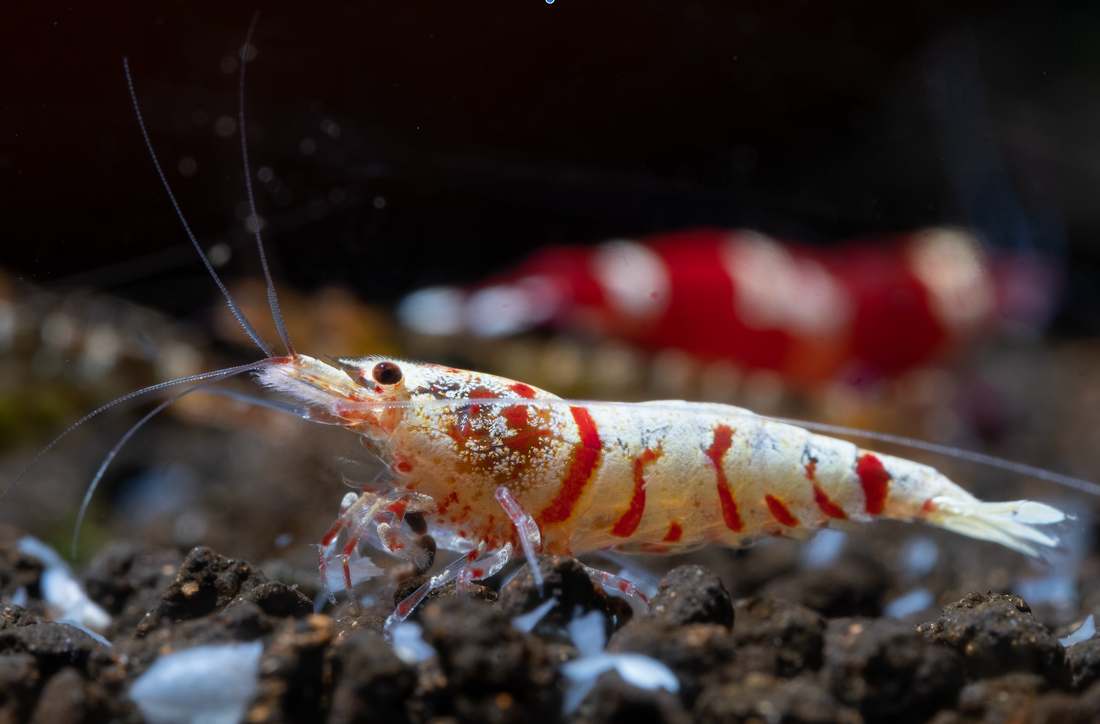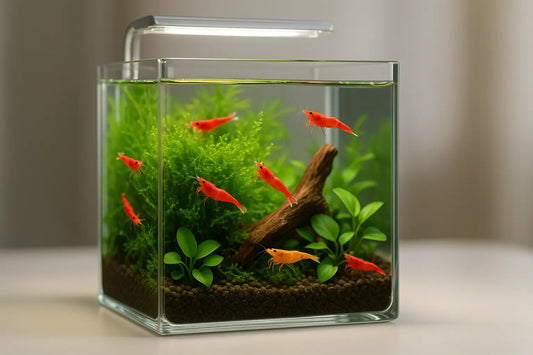
Our 3 step Guide to Successful Caridina Shrimp Breeding
We’ve found that there are 3 key factors to successfully breeding freshwater Caridina shrimp. Once you master these it’s really not too hard to get a prolific breeding shrimp colony. We find that the 3 key conditions to keep an eye on are: maintaining stability, water parameters, and providing a consistent food source. Here’s how to setup the perfect conditions for Caridina breeding:
1. Set up your tank for perfect water parameters
- Buffering Substrate: Choose a substrate that buffers pH, such as specialized buffering substrates designed for shrimp tanks. We’ve used a few kinds but currently have Brightwell Rio Escuro soil in all our tanks. This is the best way to keep a consistent pH. Crushed coral, chemicals, and other solutions all fluctuate too much and end up being unpredictable.
- Remineralizing RODI Water: Use reverse osmosis/deionization (RODI) water and remineralize it to a TDS of 110 creates levels suitable for shrimp breeding. We use Salty Shrimp GH+ but there are other products out there that are suitable as well. This puts the GH at 4-6 dGH and a KH of 0 dKH, ensuring consistency to prevent stress and support breeding behavior.
2. Stable Water Conditions
Shrimp love stability, and poor conditions are better than a sudden change (with some exceptions). Ensure stable water conditions by:
- Avoiding Sudden Changes: temperature, substrate, TDS should all be changed as gradually as possible
- Water changes: we do a 15-20% water change every other week with remineralized RO water to 110 TDS. We use Salty GH+ and find that to be the perfect mix.
- Monitoring pH and Temperature: Maintain a pH between 6.0 and 7.5 and a stable temperature of 72-78°F (22-26°C). It’s worth occasionally checking just in case soil stops buffering or a heater breaks.
3. Constant Food Source with Biofilm
Foster a natural food source by:
- Encouraging Biofilm Growth: Biofilm serves as a vital food source for shrimp, especially juveniles. Allow plants and tank to develop a thin layer of biofilm by minimizing excessive cleaning and avoiding chemical additives that can disrupt its growth. Use Bacter AE to help with biofilm.
- Feeding Variety: Supplement biofilm with a varied diet including high-quality shrimp food or flakes, blanched vegetables (e.g., zucchini, spinach), and occasional treats like frozen or live foods (e.g., bloodworms, daphnia).
- Feeding Frequency: We feed every other day and remove food that hasn’t been eaten after a couple hours
- Feed the Juveniles: Use powder food and snowflake food that can be left out for a while so that the juveniles aren’t outcompeted by the adults for the pellet food
Conclusion
Once you dial in these factors, breeding Caridina is a breeze!. By creating an environment that mimics their natural habitat and supports their specific needs, you can enhance the health and breeding success of these fun freshwater shrimp. Patience and careful observation of shrimp behavior will ultimately lead to a thriving aquarium with the joy of witnessing new generations of shrimp.


